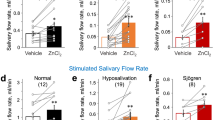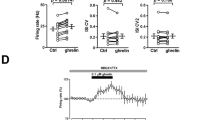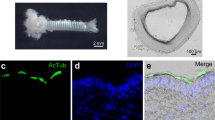Abstract
Substance P, a naturally occurring polypeptide of mammalian origin1, has been implicated both as a neurotransmitter and a neurohormone2. However, little is known of the ionic mechanisms underlying the postsynaptic response to substance P. In myenteric neurones Katayama and North3 reported substance P-evoked depolarisations (of varying latency) associated, surprisingly, with a decrease in membrane conductance. A direct measurement of reversal potential in normal ionic conditions was not achieved but it was suggested that substance P acts by reducing membrane potassium conductance. In contrast, work on salivary glands suggests that substance P evokes an increase in potassium conductance4,5; however, electrophysiological work has not been carried out to verify this. We report here that substance P evokes a marked increase in rat parotid acinar cell membrane conductance associated with a potential change (latency 1.7 s) that reverses at about −65 mV. The reversal potential for substance P is shown to be identical to that obtained in the same cells for acetylcholine (ACh) and adrenaline. The identical membrane action of ACh, adrenaline and substance P, mediated by three separate receptor sites, suggests activation of a common effector mechanism.
This is a preview of subscription content, access via your institution
Access options
Subscribe to this journal
Receive 51 print issues and online access
$199.00 per year
only $3.90 per issue
Buy this article
- Purchase on Springer Link
- Instant access to full article PDF
Prices may be subject to local taxes which are calculated during checkout
Similar content being viewed by others
References
Bertaccini, G. Pharmac. Rev. 28, 127–177 (1976).
Barker, J. L. Physiol. Rev. 56, 435–452 (1976).
Katayama, Y. & North, R. A. Nature, 274, 387–388 (1978).
Putney, J. W. J. Physiol., Lond. 281, 383–394 (1978).
Rudich, L. & Butcher, F. R. Biochim. biophys. Acta. 444, 704–711 (1976).
Nishiyama, A. & Petersen, O. H. J. Physiol. Lond. 238, 145–158 (1974).
Henry, J. L., Krnjević, K. & Morris, M. E. Can. J. Pharmac. 53, 423–432 (1974).
Krnjević, K. & Morris, M. F. Can. J. Pharmac. 52, 736–744 (1973).
Roberts, M. L. & Petersen, O. H. J. Membrane Biol. 39, 297–312 (1978).
Iwatsuki, N. & Petersen, O. H. J. clin. Invest. 61, 41–46 (1978).
Clendinnen, B. G., Reeder, D. D., Davidson, W. D. & Thompson, J. S. Archs Surg. Lond. 101, 596–598 (1970).
Trautwein, W. & Dudel, J. Pflügers Arch. ges. Physiol. 266, 324–334 (1958).
Roberts, M. L., Iwatsuki, N. & Petersen, O. H. Pflügers Arch. ges Physiol. 376, 159–167 (1978).
Author information
Authors and Affiliations
Rights and permissions
About this article
Cite this article
Gallacher, D., Petersen, O. Substance P increases membrane conductance in parotid acinar cells. Nature 283, 393–395 (1980). https://doi.org/10.1038/283393a0
Received:
Accepted:
Issue Date:
DOI: https://doi.org/10.1038/283393a0
This article is cited by
-
Changes in cytosolic calcium during cholinergic and adrenergic stimulation of the parotid salivary gland
Pfl�gers Archiv European Journal of Physiology (1983)
-
Are there purinergic receptors on parotid acinar cells?
Nature (1982)
-
Parotid acinar cells: Ionic dependence of isoprenaline-evoked membrane potential changes
Pfl�gers Archiv European Journal of Physiology (1982)
-
Mechanisms of slow postsynaptic potentials
Nature (1981)
-
Substance P: Indirect and direct effects on parotid acinar cell membrane potential
Pfl�gers Archiv European Journal of Physiology (1981)
Comments
By submitting a comment you agree to abide by our Terms and Community Guidelines. If you find something abusive or that does not comply with our terms or guidelines please flag it as inappropriate.



